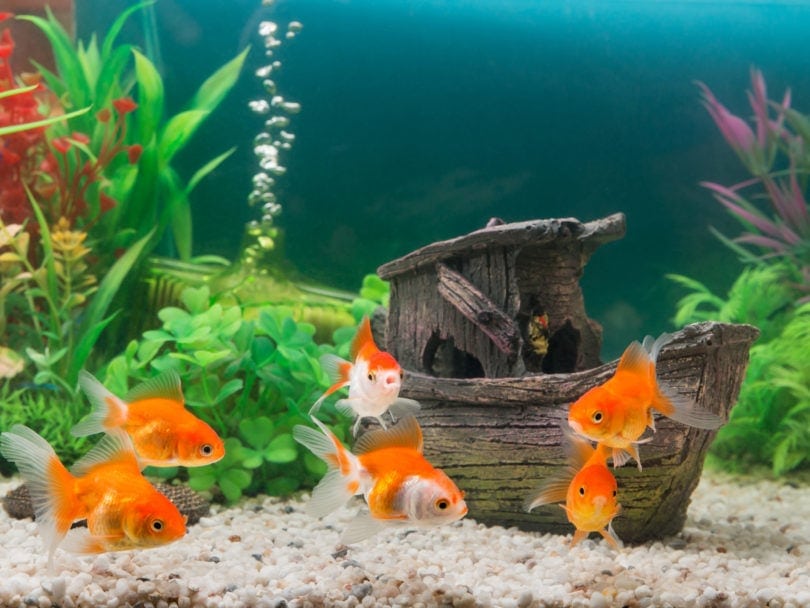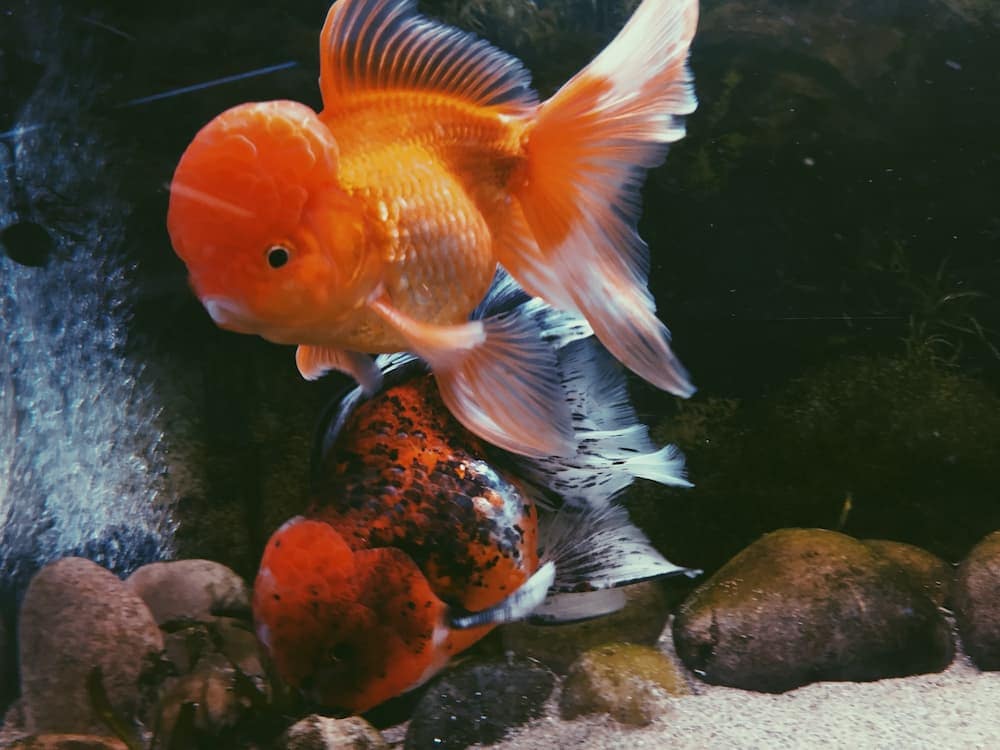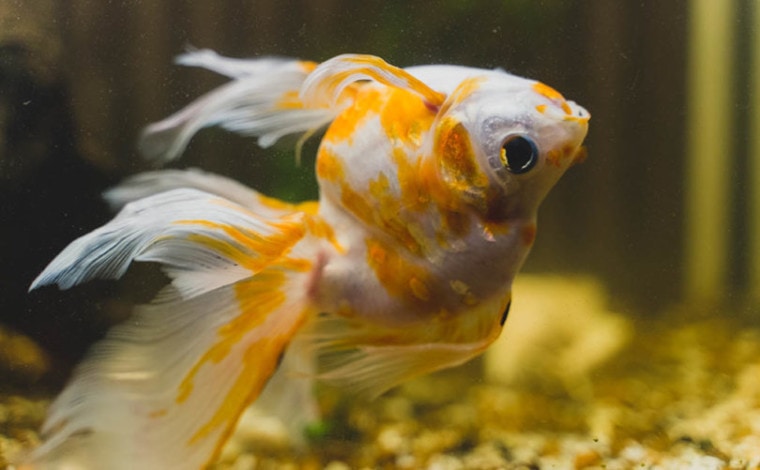
Click to Skip Ahead
Anyone who has ever kept goldfish knows that even with the best care, goldfish can still get sick. Sometimes it’s unavoidable, and you just have to roll with the punches. But sometimes, it can be really difficult to determine when your goldfish is sick. They’re hardy fish that can brush off symptoms that would kill lesser fish. You have to know what to watch out for so you can catch problems early and give your goldfish the best shot at successful treatment of illness. If you’re unsure what warning signs to watch for when it comes to goldfish illnesses, here are the things you should know.
What’s the Number 1 Cause of Goldfish Illnesses?
Without a doubt, the top cause of diseases in goldfish is poor water quality. There are multiple infections that can be direct results of poor water quality. The best cure is prevention, so get well-acquainted with what your water parameters should be and invest in a high-quality water testing kit, like the API Freshwater Master Test Kit, so you always know what your water parameters are. If you know what your parameters are, you can immediately start improving your water quality. Treating your goldfish for an illness but leaving them in poor water quality will defeat the purpose of the treatment.
There are four main parameters you should be monitoring in your goldfish’s tank:

The 14 Scale, Fin, and Skin Related Symptoms
1. White flecks
Small white flecks that look like grains of salt scattered across your fish is likely related to ich, which is a contagious but treatable parasitic infection. If you notice similar white flecks that are concentrated on your goldfish’s gill covers and the fronts of the pectoral fins, then your fish is likely a male who is ready to breed. These are called breeding stars and they allow males to encourage females to release eggs for spawning.
2. Cotton-like patches
White, cottony patches on the scales or fins are usually related to fungal infections. These may start in a small, concentrated area, but they will spread. If you are treating for a fungal infection and the patches continue to spread, then you likely need a different or secondary treatment.
3. Milky secretions
Goldfish produce a protective coating called a slime coat. When they are stressed from poor water conditions, they may overproduce their slime coat. This is noticeable by a milky film that will likely be noticeable over most of your goldfish’s body. There are products that can be used to help stimulate healthy slime coat production while you are working to improve the water quality.
4. Sores
Red, open wounds on the skin, also known as ulcerations or ulcers, can have several causes, including poor water quality, bacterial infections, and parasitic infections. Get a close look if your goldfish will allow it so you can determine the cause of the wound. Ulcers will continue to worsen without treatment and can lead to systemic infections and death.
5. Lumps and bumps
Goldfish can develop tumors, which are almost always untreatable. However, they aren’t a death sentence, and many goldfish live a long time with tumors and growths. If your goldfish develops a lump, you can have it evaluated by a fish veterinarian who may be able to provide treatment options to you.

6. Suddenly black scales or fins
If your goldfish suddenly develops patches of black scales or black areas in the fins, this can be a sign of healing, usually from an injury or ammonia poisoning. Continued exposure to high ammonia levels can lead to the development of black patches, even before the levels begin to come down. Keep in mind that some goldfish will change colors as they age, so the development of black areas isn’t always indicative of a problem.
7. Worm-like attachments
Anchor worms are parasitic worms that attach on the skin under the scales and around the gills. When they are on or around the gills, you may lose sight of them as your fish moves its gills. They are small but visible and can be treated with antiparasitic medications.
If your fish isn't behaving or looking as it normally does and you suspect it may be sick, ensure you provide the right treatment, by checking out the best-selling and comprehensive book The Truth About Goldfish on Amazon today. It has entire chapters dedicated to in-depth diagnoses, treatment options, a treatment index, and a list of everything in our fishkeeping medicine cabinet, natural and commercial (and more!).
8. Scale loss
If you notice your goldfish appears to have scales that are peeling back before falling off, this is often related to ammonia poisoning or other irritants causing burns. Goldfish can knock scales off by bumping into objects within the tank or from bullying and breeding activities. Scale loss from burns may result in patches of skin without scale coverage, but scales lost to injuries usually will grow back.
9. Hole in the head
Caused by parasites, hold-in-head disease is exactly what it sounds like and is characterized by your goldfish developing a hole in its head. This infection is severe and should be treated immediately. Hole in head disease is uncommon in goldfish.
10. Jagged fins
Jagged fins caused by poor water quality can involve any fins on your goldfish. Ammonia poisoning and burns, fin rot, and hexamita can all result in jagged fins. If your goldfish has jagged tail fins only, this can be related to fin nipping and bullying within the tank. It’s also not uncommon for fancy goldfish and long-finned goldfish, like comets, to catch and tear their fins on jagged or sharp edges in the tank.
11. Red-streaked fins
These are usually related to high ammonia or nitrite levels within the tank, leading to small hemorrhages in the blood vessels throughout the fins. It’s also possible for some internal infections to cause red streaking, so if your water parameters are normal, your fish may require treatment for a bacterial infection.
12. Loss of fins
If your goldfish begins to lose its fins, it’s usually caused by poor water quality. If it begins to lose entire fins down to the nub, this is likely related to an ammonia burn. Fins may or may not grow back once lost.
13. Pallor
Pale skin or gills can be an indicator that your goldfish is losing blood somewhere, potentially internally, or that they are suffering from an internal infection that their immune system is having to focus on. Ammonia, nitrite, or pH levels being out of normal parameters may also lead to paleness. Some goldfish will change from gold to white as they grow from a juvenile to an adult, so it isn’t always an indicator that your goldfish is sick.
14. Abdominal redness
Redness on the belly of your goldfish is usually an indicator that nitrite levels are elevated. This redness can be caused by internal bleeding that is settling in the abdomen or by skin irritation. This is usually indicative of end-stage nitrite poisoning and is rarely treatable.
The 8 Behavior Related Symptoms
15. Air gulping
This isn’t always an indicator that your goldfish is sick. Goldfish have a labyrinth organ, which functions in a similar fashion to a lung, so they are able to breathe room air by pulling it in through their mouth. Some goldfish just like to do this and there isn’t a real cause for it. If this is a new behavior, assess your tank to make sure the water is adequately oxygenated. Oxygenation and aeration can be achieved through proper water filtration and the addition of air stones and bubblers. It’s important to check your water parameters when you spot this behavior to make sure everything is at the proper level.
16. Flashing
Flashing can best be described as darting erratically around the tank. It can be caused by parasites or skin infections that are causing itchiness or a burning sensation and is most commonly associated with ich.
17. Jumping from the tank
There are a bunch of reasons your goldfish may jump from the tank, and it isn’t always intentional. If your goldfish is flashing or trying to escape bullying or breeding behaviors, it may accidentally jump from the tank. Tank jumping can also be caused by poor water quality or sudden changes in water parameters, so verify everything is in check if you’ve caught your fish trying to jump ship.
18. Lethargy
Unfortunately, this is a nonspecific symptom that can be related to many illnesses. Keep an eye on your goldfish to see if it exhibits other symptoms combined with lethargy, like poor appetite, swimming upside-down, or bloating. These can all help you narrow down the treatment options for your goldfish by narrowing down the potential causes of lethargy.
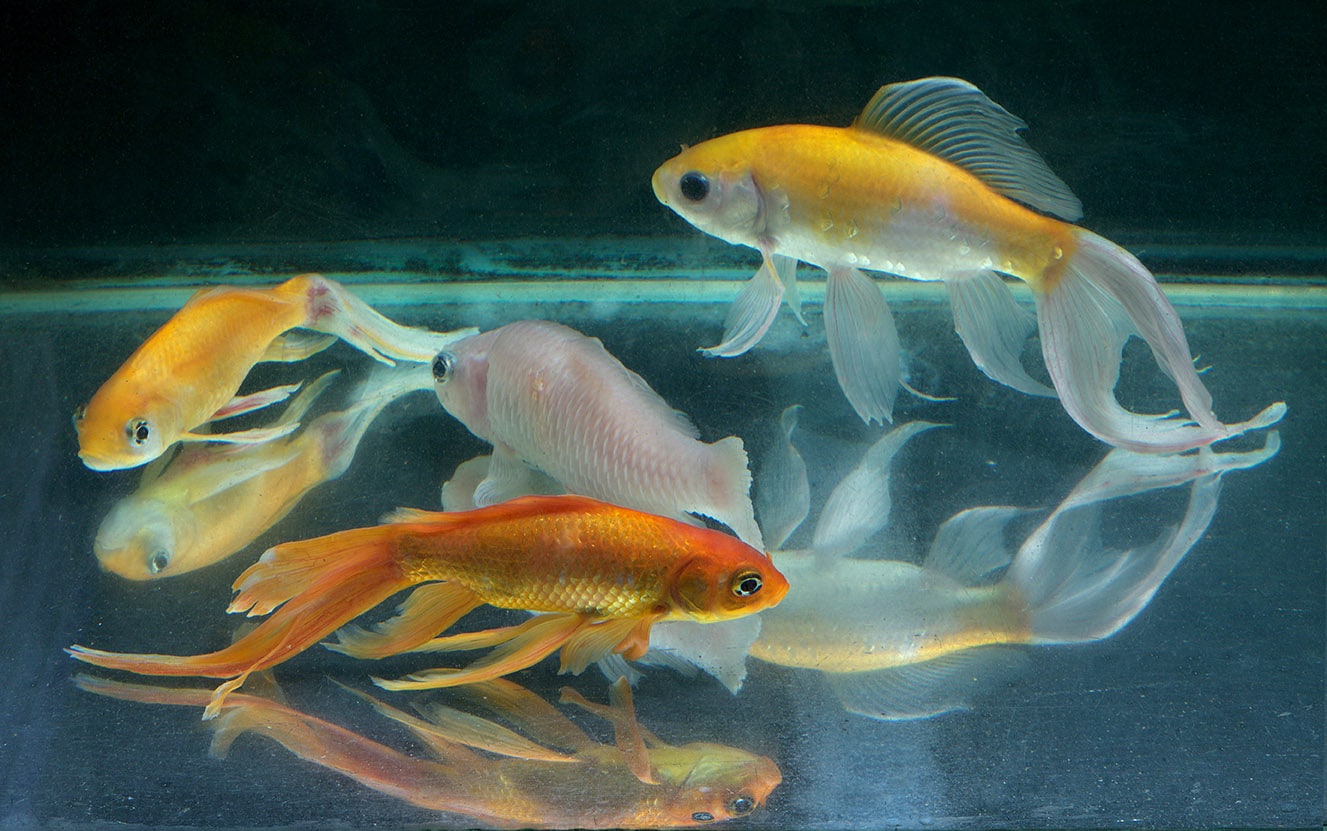
19. Spasming
Similar to flashing, spasms or twitching can accompany poor water quality or infections that are causing skin or fin irritation.
20. Bottom-sitting
Another nonspecific symptom, see if you can spot other symptoms your goldfish is exhibiting with bottom-sitting. Very few goldfish will rest on the bottom of the tank without attempting to forage. Bottom-sitting can be caused by severe lethargy, constipation, or internal infections.
21. Fin clamping
If you notice your goldfish is keeping its dorsal fin clamped down close to its body, then it’s stressed for some reason. This can be poor water quality, overcrowding, parasites, skin irritation, and other infections.
22. Nipping
There are two main reasons you’ll see your goldfish nipping at other fish; your goldfish is either a bully or a male that is ready to breed. Some bullying behaviors are related to overcrowding and water quality issues, but it’s usually that your fish is on the aggressive or touchy side. Bully fish can benefit from dividers or large breeder boxes to help them calm down. Males will chase females that are ready to release eggs and nip at her belly and the area around the anal and caudal fins. This is part of the attempt to get the female to release her eggs for spawning.
The 6 Swimming Related Symptoms
23. Swimming upside-down
Goldfish have an organ called a swim bladder that allows them to control their buoyancy. Swim bladder disease causes difficulty controlling this organ, which can result in your fish flipping upside-down and having difficulty flipping back over. Constipation and overfeeding can cause or exacerbate this problem and, in some cases, it can be remedied by withholding feedings for a couple of days or offering small bites of shelled, cooked peas. Peas are high in fiber and sometimes can help get things moving again for your fish. Epsom or aquarium salt soaks can also help.
24. Inability to “right”
If you notice your goldfish is listing to one side or swimming in odd, wobbly patterns at a normal speed, it’s likely caused by swim bladder problems.
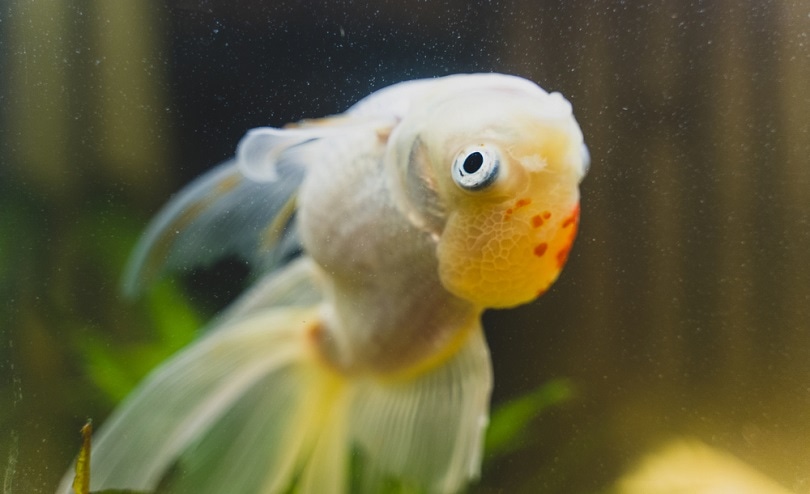
Respiratory Related
25. Gill inflammation
Swelling and redness around the gills can indicate bacterial gill disease, parasites, or other infections. However, it’s important to note that the external part of your goldfish’s gills is a gill cover. The gill itself is a red membrane underneath the gill cover that is sometimes confused with irritation.
26. Gill fusion
Bacterial gill disease can cause your goldfish’s gills and gill covers to fuse to the skin around the gills. If caught early enough, this can be treated, but once the gills fuse, it’s usually not possible to release the gills and repair the damage.
27. Holes in gills
Holes in the gill covers or gills themselves are caused by bacterial gill disease. They can be treated, but it’s unlikely you’ll see the gills or gill covers fully heal.
28. Rapid breathing
If you just brought your goldfish home or moved it to a new tank, then rapid breathing is to be expected from the stress of the trip or change. If your goldfish is bottom-sitting and breathing rapidly or staying near the surface of the water and breathing rapidly, then you likely need to oxygenate and aerate the tank better. Verify your water parameters are in order as well.
The 8 Mouth and Abdomen Related Symptoms
29. Inappetence
A goldfish that won’t eat is likely extremely sick, so you need to quickly identify other symptoms to help you determine what’s going on. If your goldfish is having trouble eating due to swim bladder disease or something similar, you can attempt to hand feed or offer smaller pieces of food. If your goldfish is ignoring food entirely, then this is a major cause for concern.
30. Spitting food out
If your goldfish is taking food into its mouth and then spitting it back out, it may be because it’s having mouth swelling or pain, which can be caused by mouth rot or parasites in the mouth. Make sure you are feeding foods that are soft and small enough for your goldfish’s mouth.
31. Floating poop
Usually goldfish poop will sink, so if you notice it’s floating, your goldfish may be being overfed or not being fed a balanced diet. Your goldfish needs more than a commercial pellet or flake and should be offered fresh fruits and veggies and high-quality treats.
32. Long white poop
Sometimes, goldfish will have long, stringy poop trails behind them. If these have a little bit of white, this is just the stool casing and isn’t a concern. If the entire trail is white and stringy, then it’s likely a parasitic or bacterial infection, or a diet that isn’t balanced.
33. Mouth staying open
Goldfish will put just about anything into their mouths that will fit. Sometimes, they will get things into their mouth that they can’t spit out, like gravel. If you notice your goldfish swimming around with a gaping mouth, take a close look to make sure there isn’t anything stuck in its mouth. If there is, you can, very gently, use blunt tweezers or your fingers to work the item out of the mouth.
34. Abdominal swelling
This can be caused by the early stages of fluid collecting in the abdomen due to internal infection or disease. If your fish is an adult female, she may be egg-bound, which means that she is unable to pass her eggs on her own. This can be remedied by gently pressing on her lower abdomen to expel the eggs manually. Don’t squeeze your fish hard enough to hurt her, and if you are unable to expel the eggs, contact a local fish vet for assistance.
35. Pineconeing
Severe abdominal swelling will cause pineconing, which involves the scales flaring out from the body, creating a look similar to a pinecone. This is caused by the collection of body fluids in the abdomen and can be caused by multiple serious infections. This condition is called dropsy, and the underlying causes of dropsy aren’t always treatable by the time dropsy occurs.
36. Wasting
If your goldfish’s body begins to look gaunt or thin, then there is a serious problem. Muscle or body wasting may be accompanied with inappetence or refusal to eat, but some fish that are eating well may experience wasting. This change in body condition indicates a serious internal infection and may not be treatable by the time you recognize your fish is excessively thin.
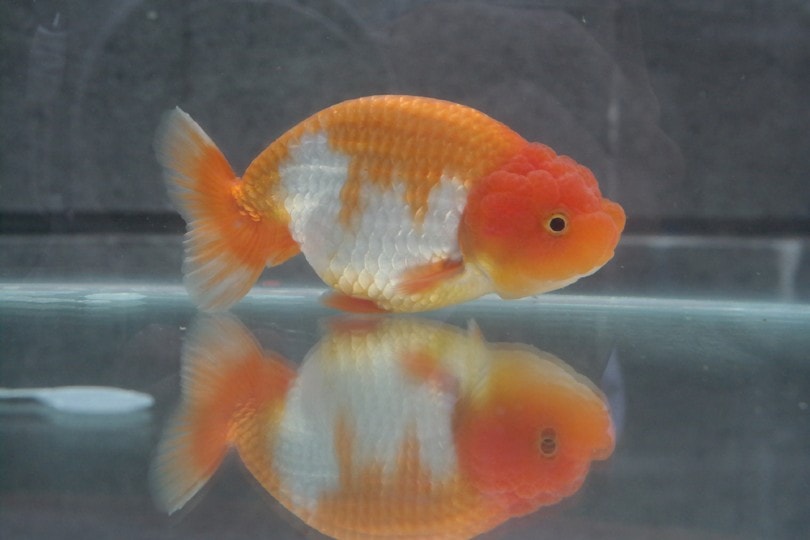
The 4 Eye Related Symptoms
37. Unusual eye bulging
If the eye is bulging but is still located in the eye socket, this is likely a disease called pop-eye, which is caused by a bacterial infection. Pop-eye is treatable, but it is possible for your goldfish to lose one or both eyes during the course of treatment.
38. Loss of eye
Pop-eye and other severe infections can lead to the loss of an eye, but it can also be caused by injury or toxins in the water or other water quality issues. Goldfish with telescope and bubble eyes are most likely to lose an eye, but it is possible for any goldfish to lose an eye. If your goldfish loses an eye, treat the underlying cause of the eye loss. You may consider treating prophylactically with an antibacterial to prevent infection from taking hold while the eye socket heals.
39. Eye cloudiness
The same things that can lead to the loss of an eye can also lead to eye cloudiness. Eye cloudiness may lead to decreased vision and an increased risk of injury. Treat the underlying cause, which is likely a bacterial infection or water quality problem. Your goldfish’s eye may not heal, but they will quickly adjust to limited vision. Make sure your goldfish is getting enough to eat and hand feed if necessary.
40. Eye redness
Redness or swelling in or around the eyes is usually caused by infection or injury. Treat the underlying cause and monitor the eyes closely.
Conclusion
Identifying what’s wrong with your goldfish based on its symptoms can be difficult, especially if your goldfish is exhibiting multiple symptoms or nonspecific symptoms. There are great options for medications for fish that don’t require prescriptions. They usually say on the package exactly what conditions the product can treat and the label will clearly define how to use the product for maximum safety and efficacy. If your fish is sick and you’re unsure of a diagnosis, reach out to a veterinarian who specializes in fish for guidance. Be cautious with treating a sick goldfish without having a good idea of what’s wrong. Unnecessary medications can lead to increased stress on your fish and can make it sicker.
Featured Image Credit: M-Production, Shutterstock



